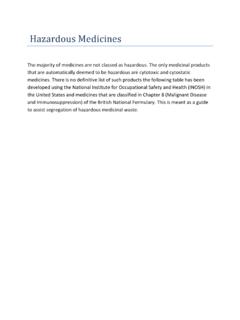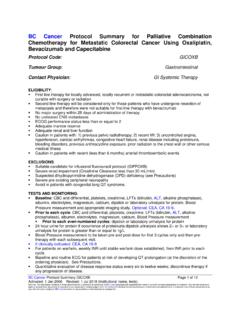Transcription of Assessment report - European Medicines Agency
1 7 Westferry Circus Canary Wharf London E14 4HB United Kingdom An Agency of the European Union Tel pho +44 (0)20 7418 8400 Facsimile +44 (0)20 7523 7455 E-mail Website 15 November 2012 EMA/755420/2012 Committee for Medicinal Products for Human Use (CHMP) Assessment report Zaltrap International non-proprietary name: aflibercept Procedure No. EMEA/H/C/002532 Note Assessment report as adopted by the CHMP with all information of a commercially confidential nature deleted. Zaltrap CHMP Assessment report Page 2/91 Executive Summary Colorectal cancer (CRC) is one of the most common cancers in both men and women, and the second most common cause of cancer mortality in Europe. Significant advances in the treatment of metastatic CRC have been made during the last 25 years with the introduction of chemotherapy agents. Current therapies used in clinical practice for first and second line treatment of metastatic CRC include irinotecan or oxaliplatin, each in combination with bolus and infusional 5FU/ LV.
2 Standard second-line treatments for metastatic CRC have also evolved to include the addition of targeted biologic therapies such as bevacizumab, c etuximab and panitumumab. Despite these advances, the prognosis of patients with metastatic CRC undergoing second-line treatment is poor and the expected median overall survival is only approximately one year. In November 2012, the European Medicines Agency s Committee for Medicinal Products for Human Use (CHMP) recommended the authorisation of aflibercept (Zaltrap) in combination with irinotecan/5-fluorouracil/folinic acid (FOLFIRI) chemotherapy in the treatment of adults with metastatic colorectal cancer (MCRC) that is resistant to or has progressed after an oxaliplatin-containing regimen. The recommended dose of aflibercept, administered as an intravenous infusion over 1 hour, is 4 mg/kg of body weight, followed by the FOLFIRI regimen. This is considered as one treatment cycle.
3 The treatment cycle is repeated every 2 weeks. Aflibercept is a recombinant human fusion protein that acts as a high-affinity soluble decoy receptor that can block the VEGF pathway by preferentially binding to vascular endothelial growth factor A (VEGF-A), VEGF-B and placenta growth factor (PlGF) and preventing these factors from activating their endogenous receptors. By blocking this pathway, aflibercept is believed to exert direct anti-cancer activity and to potentiate the anti-cancer activity of chemotherapy agents by preventing new tumour vessel growth, regressing existing tumour vessels, normalising vasculature, affecting tumour cell function, offsetting of effects of chemotherapy induction of VEGF levels and potentially inhibiting VEGF repression of dendritic cell function. The demonstration of clinical benefit for aflibercept was based on a single randomised, double-blind controlled trial of aflibercept versus placebo in MCRC patients being treated with FOLFIRI after failure of an oxaliplatin based regimen (EFC10262- VELOUR).
4 The primary efficacy analysis showed a small but clinically significant difference of months in median overall survival between the study groups. In this trial, the risk of death associated with aflibercept was reduced by 18% compared to that observed in the control group (stratified Hazard Ratio , Confidence Interval: to , p= ). The median overall survival was months in the aflibercept arm compared to months in the placebo arm. Secondary efficacy endpoints were consistent with the effect observed in terms of overall survival. Aflibercept was associated with an improvement of months in duration of median progression-free survival and of 9% in objective response rate ( versus for aflibercept and placebo, respectively). The trial also included a subgroup of patients whose disease had progressed after treatment with bevacizumab. Bevacizumab has a mechanism of action similar to that of aflibercept.
5 Because of the risk of cross-resistance between the two agents, a subgroup analysis was conducted to assess if an effect of aflibercept could be observed also in patients pre-treated with bevacizumab. In this subgroup analysis, a trend towards a favourable effect on overall survival was observed for aflibercept, but no definitive conclusions could be drawn. Treatment-emergent adverse events led to permanent discontinuation of treatment in of patients in the aflibercept arm compared to of patients in the placebo arm, clearly reflecting the toxic potential of the study drug when combined with FOLFIRI. Furthermore, substantially more dose Zaltrap CHMP Assessment report Page 3/91 modifications and premature discontinuation of all study drugs as well as cycle delays were seen in the experimental arm. However, overall exposure to background chemotherapy (irinotecan and 5-fluorouracil) on study was similar between the two treatment groups.
6 Aflibercept was associated with anti-VEGF class side effects including hypertension, haemorrhage and fistulae. Addition of aflibercept also increased the frequency of adverse events associated with irinotecan and 5-FU, including diarrhoea, neutropenia, and stomatitis. Severe treatment-emergent adverse events occurred in of patients in the aflibercept arm compared to in the placebo arm. Severe events with a frequency 2% higher in the aflibercept arm included diarrhoea, hypertension, asthenic conditions, stomatitis and ulceration, and dehydration. Serious treatment-emergent adverse events (defined as events that are life-threatening, result in death, require in patient hospitalisation or prolong hospitalisation, result in persistent or significant disability, are congenital anomalies/birth defects or require intervention to prevent permanent impairment or damage) were reported in of patients in the aflibercept arm compared to in the placebo arm.
7 The most common serious adverse events were gastrointestinal disorders (20% vs 11%) followed by infection and infestations ( vs ). In patients 65 years the incidence of specific AEs, such as diarrhoea, dizziness, asthenia, weight decrease and dehydration was 5% higher than in the younger population. In terms of balance of benefits and risks, the overall toxicity of aflibercept in the studied combination regimen was considered significant, not always manageable, and in some patients ultimately leading to termination also of the chemotherapy. However, despite this toxicity, there was still a small but clinically relevant survival advantage of months (median). Thus, the benefits associated with aflibercept were considered to outweigh the risks. In order to optimise benefit risk balance, it is essential to identify the proper target population for therapy. This might be possible to accomplish through the judicious use of biomarkers in all phases of clinical drug development.
8 However, no validated predictive serum or plasma biomarkers have been identified during the development of aflibercept that correlate with treatment outcomes. Thus, the CHMP has requested to the applicant company to analyse plasma and tissue samples from the available trials, with the primary aim to identify biomarkers to allow better selection of the population likely to experience a beneficial effect following treatment with aflibercept. Finally, individual patient decisions should be based on clinical judgement and also take into account patient preferences. Zaltrap CHMP Assessment report Page 4/91 Product information Name of the medicinal product: Zaltrap Applicant: sanofi-aventis groupe 54, rue La Bo tie 75008 Paris France Active substance: aflibercept International Nonproprietary Name: aflibercept Pharmaco-therapeutic group (ATC Code): Other antineoplastic agents (ATC Code not yet assigned) Therapeutic indication: Zaltrap in combination with irinotecan/ 5-fluorouracil/ folinic acid (FOLFIRI) chemotherapy is indicated in adults with metastatic colorectal cancer (MCRC) that is resistant to or has progressed after an oxaliplatin-containing regimen Pharmaceutical form: Concentrate for solution for infusion Strength: 25 mg/ml Route of administration: Intravenous use Packaging: vial (glass) Package sizes.
9 1 vial with 100mg/4ml 1 vial with 200mg/8ml 3 vials with 100mg/4ml Zaltrap CHMP Assessment report Page 5/91 Table of contents 1. Background information on the procedure .. 8 Submission of the dossier .. 8 Steps taken for the Assessment of the product .. 9 2. Scientific discussion .. 10 10 Quality aspects .. 11 Introduction .. 11 Active Substance .. 11 Finished Medicinal Product .. 12 Discussion on chemical, pharmaceutical and biological aspects .. 14 Conclusions on the chemical, pharmaceutical and biological aspects .. 15 Recommendations for future quality 16 Non-clinical aspects .. 16 Introduction .. 16 Pharmacology .. 16 20 Toxicology .. 21 Ecotoxicity/environmental risk Assessment .. 27 Discussion on non-clinical 27 Conclusion on the non-clinical aspects .. 30 Clinical aspects .. 30 Introduction .. 30 31 Pharmacodynamics .. 35 Discussion on clinical pharmacology.
10 37 Conclusions on clinical pharmacology .. 38 Clinical efficacy .. 38 Dose response 38 Main study .. 40 Supportive studies .. 55 Discussion on clinical efficacy .. 55 Conclusions on the clinical efficacy .. 56 Clinical safety .. 57 Discussion on clinical safety .. 76 Conclusions on the clinical safety .. 79 Pharmacovigilance .. 80 User consultation .. 85 3. Benefit-Risk Balance .. 86 4. Recommendations .. 88 Zaltrap CHMP Assessment report Page 6/91 List of abbreviations 5-FU : 5-fluorouracil ADA: Anti aflibercept antibodies AE: Adverse Event ALT: Alanine amino transferase AST: Aspartate amino transferase ATE: Arterial thromboembolic events AUC Area under the curve BMI Body Mass Index CHMP Committee for Medicinal Products for Human Use CI: Confidence Interval ClCr: Creatinine clearance DBP: Diastolic blood pressure DLT Dose Limiting toxicity DMC: Data Monitoring Committee EC European Commission ECOG PS: Eastern cooperative oncology group performance status e-CRF: electronic-Case report Form EGFR: Epidermal growth factor receptor ELISA: enzyme-linked immunosorbent assay EMA European Medicines Agency EU European Union FDA: Food and Drug Administration GCP: Good Clinical Practice HLT: High level term HR: Hazard ratio HU Hydroxyurea HUS: Hemolytic uremic syndrome HUVEC.













